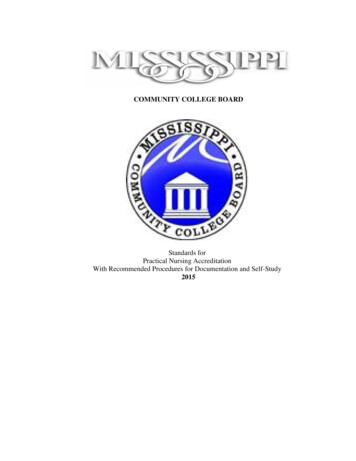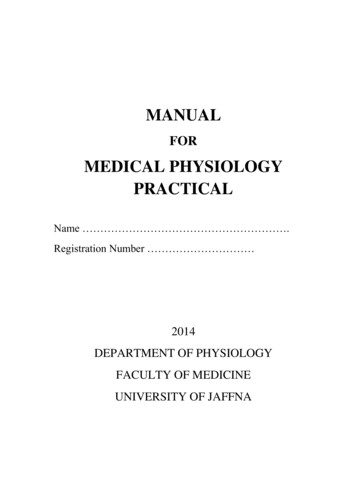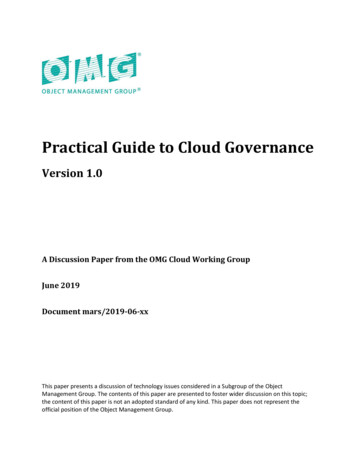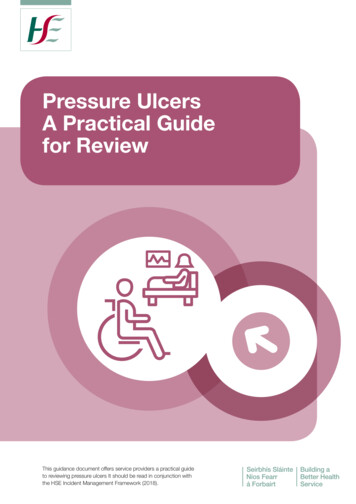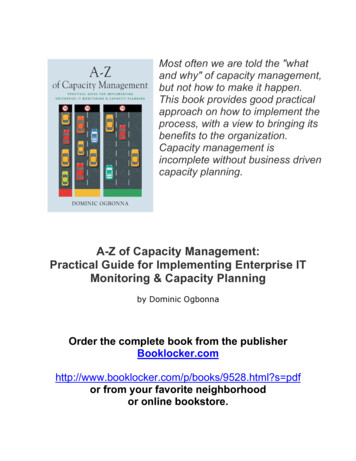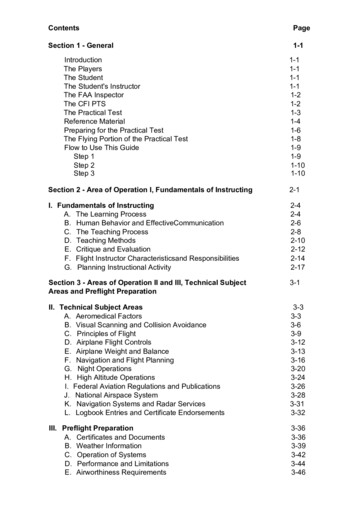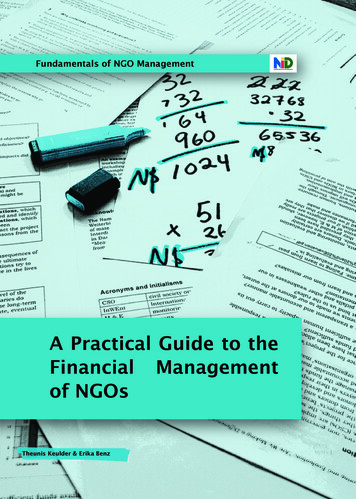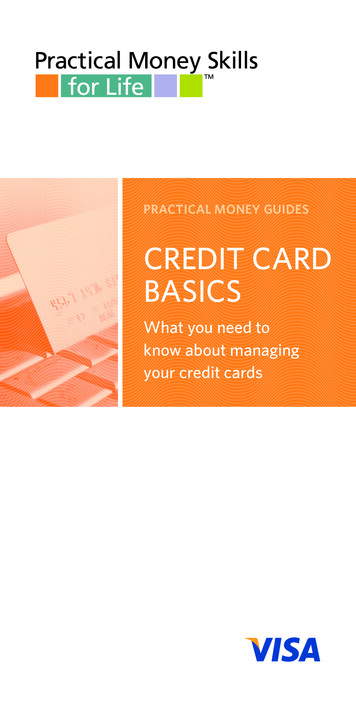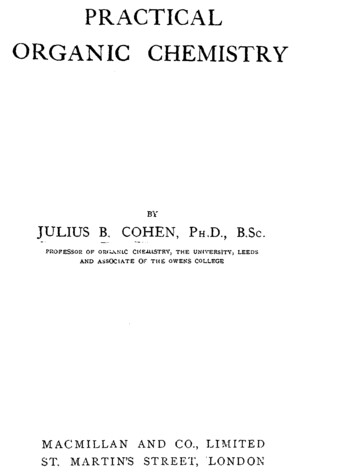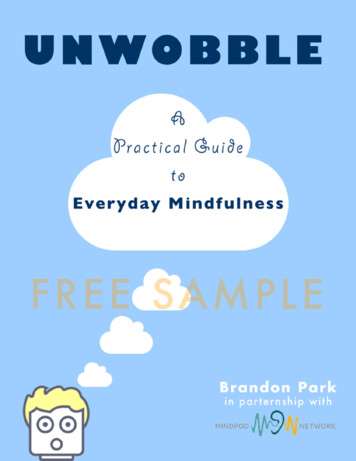
Transcription
Thanks for joining me!Hiya,There is plenty of information in the world about how to meditate.And probably as much or more info on what mindfulness means.What is lacking are clear to the point instructions for practicingmindfulness right here, right now: whether you are in the middle ofyour workday, or overwhelmed with what you have on your plate.That is what this project is about: practical mindfulness exercises tohelp with everyday life.In my journey working with some great minds in the world ofmindfulness I continually find the same pattern. Members of theiraudiences want to practice mindfulness but can’t seem to makemeditation work for them. Or they meditate but don’t feel the effectslast through the day.So I set out to find and collect as many simple, easy-to-use exercisesas possible. But not just any exercises would do. My goal was to findexercises that wouldn’t require you to sit in a quiet space for 20minutes.Because let’s face it: you don't always have that kind of time. Or thewillpower required to make it happen. You’re busy and you need anefficient solution.
What you have here is a small sample of some of the exercises I haveput together. Included are exercises to help you:- Calm down in times of stress.- Undo your negative monkey mind.- Refresh your mindset to alleviate resentment or anger.I’ve also spent time gathering helpful exercises, tips and insightsfrom various teachers.Included in this free sample you will find:- Giovanni Dientsmann shares why meditation matters and explainshow to get started.- Tara Brach explains the 3 invitations she uses to avoid reactivityand call on compassion.- Jack Kornfield teaches you how to transform sorrow intocompassion.This is a small taste of the many submissions from the companionguide I’m putting together.Enjoy this sneak peek and shoot me an email to let me know if it’shelped you.Best,Brandon Parkbrandon@unwobble.comps. I’ll be sending you more free tips and exercises in between nowand when the guide is launched. Add my email to your contacts tomake sure the emails don’t get lost.
Alternate Nostril BreathingLower your blood pressure, calmyour nerves, and reclaim your focus.This is a powerful technique that will balance your fight-or-flight and rest-andrelax systems. It’s a great exercise to use when you need to reduce your stresslevel or improve focus. Perfect for dealing with high stress moments. It shouldleave you calm but alert and focused.2-5 minutesanywhereTry It OutHold your right thumb against your right nostril and take a slow deepbreath in through your left nostril. Pause for one second.Move your thumb from your right nostril to your left nostril. Slowlyexhale through your right nostril. Pause for one second. Now slowlyinhale through your right nostril. Pause for one second.Move your right thumb from your left nostril to your right nostril. Slowlyexhale through your left nostril. Repeat all of the steps for 2-5 minutesor until Tip To Consider When you first start, try only a fewrounds This is not a good exercise forbedtime. It may keep you up. This is great if you are in need of apick-me-up. This technique may lower your bloodpressure. It is not recommended to hold yourbreath if you have high bloodpressure. This practice has long been used inyoga and Ayurvedic medicine.
Trap Your Negative MonkeyCatch your negative monkey andtorture it into telling you the truth.This is for those times when you monkey mind is in full negative downer mode. It willhelp you address and move on from the negative thoughts.2-5 minutesanywhere privateTry It OutGrab a pen and notebook or smartphone, tablet, computer to writewith.Write down one negative thought you are having. Now ask yourself; “Isthis true?” Ask yourself; “Does this thought make me feel good?” and“Does this thought make me reach my goals?”Write down 3 positive thoughts that relate to the negative thought. Forexample you can write “right now everything is ok,” or “that thought isnot truth it is only opinion.”Now list a positive emotion related to the 3 positive thoughts. Forexample, “happy,” or “hopeful,” or “pleased.”When you feel as though you have a little more control over your feelings youcan move on. Otherwise try to repeat this exercise and challenge yourself tobe more believable with the positive thoughts and more challenging with thenegative thoughts.
It Must Not Be EasyA mindset shift to turn to when you’reholding on to resentment or blame.This reframing exercise is worth turning into a habit. Instead of playing the blame game,these five simple words will get you started on forgiveness. While providing some muchneeded perspective about where the other person may be coming from.30 secondsanywhereTry It OutTurn to this exercise when you’re harboring resentment, blame oranger.Try to put yourself in the other person’s shoes and complete thefollowing statement: “It must not be easy ”For example, “It must not be easy to be a boss and manage 7 differentpersonalities.” Or, “It must not be easy to be an adolescent withhormones flowing through your Tip To Consider Remember that other people areusually reacting based on their ownissues. This does not excuse bad behavior.Instead it allows you to soften yourview of the person performing thebad behavior.
Giovanni Dienstmann (cont’d)Giovanni DienstmannIf you are interested in meditation or mindfulness, buthaven’t made a solid start yet, you may be strugglingeither with the why or the how. On the other hand, if youalready have some practice, but haven’t observed muchself-transformation yet, then you might be struggling withintegration.In this article I will cover the why and how of meditation,and present a simple practice that everyone can easilyfollow. Let’s start with the why.Part I. Why Meditation MattersYes, you have probably heard of the over 70 benefits ofmeditation, but that somehow doesn’t fire you up topractice it yet. So here is the real reason why you shouldmeditate: because you have a mind. And you are not theboss of your mind - often, your mind is the boss of you.Meditation helps you have greater mastery over yourmind, by helping you develop four “superpowers”:zooming in, zooming out, pausing, and changingchannels.
Giovanni Dienstmann (cont’d)And all of these are developed out of the coremindfulness exercise of: observing your mind noticing distracting pausing and bringing the attention back.1. Zooming inFocusing means that you can zoom in your attention onanything, and sustain it there, ignoring distractions.As we live in times of continuous distraction, ourattention span keeps getting shorter. Having the ability tofocus is very useful in all spheres of your life: career,education, relationship, finances, and performance.2. Zooming outThis is the ability to not get sucked into mental andemotional states that you don’t want to. It’s the ability tosee with clarity and serenity.Zooming out is specifically handy when troublesomeemotions and addictive thought patterns have taken hold
Giovanni Dienstmann (cont’d)of you. It frees your mind and gives you perspective tosee things afresh.3. PausingWe often live in an unconscious, automated way. Thismeans we become the product of our environment. Wereact, rather than respond. In this mode, we are acting onthe loudest impulse in our heads. We’re reproducing ourpast conditioning - many times in regrettable ways.Living a creative and fulfilling life requires just theopposite. It means to be intelligently present in themoment, acting fresh. For that, the ability to pause isessential.4. Changing the channelThink of your mental world as a TV with several channels.Some of them are informative, entertaining, or useful.Others are full of bad shows, even though you might findthem addictive.The problem is: your remote control isn’t workingproperly, and the TV is just displaying whatever channelsit wants, in the volume it wants.
Giovanni Dienstmann (cont’d)The more you develop the abilities to pause, zoom out,and zoom in, the more you fine tune your remote control.As a result, your favorite channels get more screen time,and the unhelpful ones end up being discontinued dueto lack of attention.Part 2. Mini-Meditation Moments (MMM)Have you seen what the powers of zooming out, zoomingin, pausing and changing channels can do for you?Great. So now we will explore what I considered to bethe easiest way to get started with meditation - or tobetter integrated it in your daily life, if you already have apractice. I called it MMM, or mini-meditation moments.The idea is that once per hour, or once every two wakinghours, you get reminded to pause whatever you aredoing, and introspect your attention for a short minuteor two.1. ReminderThe best way I found to reliably get reminded is by usingtechnology. These are the three tools I have used for thispurpose:
Giovanni Dienstmann (cont’d) MeaningToPause — a lovely bracelet that vibratesonce every 60 or 90 minutes, in a non-intrusive way(link). Built for this purpose. FitBit — allows you to add up to 8 reminders a day(link). I researched other wearables but they usuallyonly allow up to 4 reminders. Mobile apps — there are also apps that help youachieve the same result, like Mindfulness Mynah andMindfulness Reminders. I personally prefer not to useapps for this, since it relies on the already distractingworld of your smartphone.2. IntrospectionOnce you get reminded, you then do a mini-practice.The practice could be bringing your attention to thenatural flow of breath, or repeating a mantra a few times,or bringing loving-kindness into the heart, or whateveryour main meditation is about.What I personally do and recommend it to actuallymodulate your breath. Take a few deep, long, and slowbreaths. You will be surprised at how this simple exerciseshifts your mental, physical, and emotional states.Here is a 5-week course in mini-meditation moments I’d
Giovanni Dienstmann (cont’d)like to suggest. These are brief instructions for theexercise you do multiple times a day, during the 1-2minutes of your mindful pause. Week 1: Breathe in as deeply and slowly as you can,counting 10 at the end of it. Then breath out equallydeep and slow, counting 9. Proceed until reaching 1. Week 2: As you breathe in, count 6 seconds; as youbreathe out, count 6 seconds. Do this for 10 breaths.Slowly increase the length of the breaths, withoutforcing. If 6 is hard, start with to 4 or 5. Feel yourwhole body while breathing, and consciously relax it. Week 3: Do as in week 2, but this time place yourright hand on your belly, and left hand on your chest.Follow abdominal breathing, which means thatbreathing in and out, only your right hand shouldmove. When inhaling, gently push your abdomenforward; when exhaling, pull it back. Keep yourattention in the counting and on the moving hand. Week 4: Keep the abdominal breathing and thecounting, but start making the exhalations longer thanthe inhalations. Gradually, the breathing out should beguided to become double length than the breathingin. For example, if you inhale for 5 seconds, exhale for10.
Giovanni Dienstmann (cont’d) Week 5: Keep the abdominal breathing and thecounting, but now introduce a small breath retention,of the same duration of your inhalation. So if youbreathe in for 5 seconds, gently hold for 5 seconds,and breathe out for 10 seconds - 5:5:10.In all of these five weeks, your goal is to keep yourattention 100% engaged with the process of breathingand counting. If distraction happens, just let go of it, andbring your mind back to breathing.These exercises are simplified forms of pranayama, whichare breathing exercises in the Yoga meditation tradition.They are a great help in developing some of the benefitsof meditation in a short period of time, and also inintegrating or preparing for a formal practice.May this practice allow you to have a greater level ofmastery over your mind, and release thoughts andemotions that don’t serve you.
Giovanni Dienstmann (cont’d)Giovanni Dienstmann is a meditation teacher, the writer behind thepopular blog LiveAndDare.com, and the creator of the acclaimed MasterYour Mind program. He has been intensely seeking personal growth andenlightenment since his teenage years. In this process, he has practicedmeditation daily (totaling over 7,000 hours), read hundreds of books,tried several different techniques, and spent time on retreats withmasters and instructors around the world.All this practice, learning and training has radically transformed his mindand experience of the world - as a result, he now lives a fearless,peaceful, and content life. Giovanni is not a guru or a spiritual master –but a practitioner on the way, sharing the powerful tools and insights thathave helped him thus far. His work is to translate, synthesize and“update” the tools and teachings of world-wide wisdom traditions sothat they are easily digestible for the 21st-century person.If you want to learn more about these topics, check out these two posts:Mindfulness Tools to Integrate Meditation In Daily LifeThe 4 Superpowers of Meditation
Tara Brach (cont’d)Tara BrachWaking up from Reactivity: ThreeInvitations to Remembering TruthThere are three key teachings that have shaped my life ina very deep way. Each of these teachings is a way to freeyourself from the suffering of reactivity so that you canrespond to life in a more compassionate way. I like tothink of each as an invitation:Please, don’t believe your thoughts.We spend most of our days lost in thought. We spendmost of our time in a virtual reality.If you think back on your day you will notice how much ofthe day was lost in moments of living inside thatincessant dialogue going on in your brain. I know this istrue for me.When we start catching on to this invitation - Please don’tbelieve your thoughts - it creates a little more spacearound that virtual reality and a little more possibility toinvestigate our thoughts and choose to step out of thedream they create. It’s helpful to ask yourself: Are thesethoughts serving healing? Are they helping me connect
Tara Brach (cont’d)with others? Or are they limiting me by fueling self-doubtand a sense of separateness?The point isn’t to get rid of thoughts, but to know thatthey’re there so you don’t mistake them for reality.You have a choice. If there’s even a little bit of you thatsays, “Please, you don’t have to believe what thisthought is telling you,” you’re on the right track. Or if youremind yourself, “I’m not my thoughts,” you’re openingthe door of awareness and letting the light comethrough. Simply remembering this possibility promotes aradical shift in consciousness.Please, pause and come back into presence.The most challenging part of this invitation is that, whenwe come into the present moment, part of what wecontact is the unpleasant, uncomfortable stuff that isgoing on in our body and heart—the very stuff we’vemanaged, over a lifetime, to not hang out with.We’ve spent decades learning how to move away fromdifficult feelings. So this simple invitation - Please, may Ipause and be with what’s right here - is like saying,“Please may I pause and feel the fear that’s here, thesensations of being squeezed and achy and sore.” Andwhen we directly contact the emotional or physical painor confusion going on inside us, it’s not easy to learn tostay.
Tara Brach (cont’d)However, it’s possible and profoundly healing. Whichleads us to the third invitation.Please, remember love.If we regard whatever’s going on inside us with a qualityof tenderness, all of a sudden we find out we can stay.There’s just enough space, softness and kindness so thatwe can hang out with what’s here—because we’re not soinside of it and caught in it as a victim. When, in someway, there is a remembrance of love, then what we areopens and we become a bigger space of presence.There are countless pathways to remembering love. Thisis an experiment for each of us and we have to exploreand try things out.One pathway of remembering love is to simply have theintention to offer love or care inwardly. It can be throughwords or images. You might consider whether there isany message that would bring healing, wisdom, comfortor truth into your own being. I often put my hand on myheart. The warmth in the neural center of the heart areaof your chest actually calms down the sympatheticnervous system. I also send a caring message, like “It’sokay, sweetheart.” Others might say something like “I’mwith you,” or “You can relax now, you’re doing fine.”Even having the intention and going through the motionsworks. Why does it work? Because deep down, who we
Tara Brach (cont’d)are is loving presence. By going through the motions, webegin to reach back for it and reconnect with more of thetruth of who we are.So one pathway to remembering love is to offer loveinwardly. Another pathway is to call on the love that weknow is in the universe and ask to be held by it.When a young child is upset, they are comforted by theirmother’s hug. This actually helps them self-regulate.When you imagine being hugged, that imagining doesthe same thing.To the degree that we suffer, we are believing thoughtsthat are not true and we are caught in some kind ofreactive looping that keeps us identified with somethingthat is smaller than the truth of who we are.We all need ways to remember—practices of presence.We need to train ourselves to take the time to pause andlearn not to believe our thoughts to pause and comeinto presence to pause and be kind.So the next time you have limiting, harmful thoughts,remember for yourself: Please don’t believe this thought,please be here, and please be kind. You might find ithard to remember at first but, with practice, these threeinvitations have the power to bring peace, wisdom and adeep experience of inner freedom.
Tara Brach (cont’d)Tara Brach, Ph.D is a clinical psychologist, meditationteacher and author of bestselling Radical Acceptance andTrue Refuge. Over a million people each month tune into Tara’s podcast. In addition to her public teaching, sheis active in bringing meditation into the Washington, DCarea schools, prisons and to underserved populations.www.tarabrach.com
Jack Kornfield (cont’d)Jack KornfieldTransforming Sorrow IntoCompassionThe human heart has the extraordinary capacity to holdand transform the sorrows of life into a great stream ofcompassion. It is the gift of figures like Buddha, Jesus,Mother Mary, and Kwan Yin, the Goddess of Mercy, toproclaim the power of this tender and merciful heart inthe face of all the suffering of the world. Whenever yourown heart is open and uncovered, the awakening of thisstream of compassion begins within. Compassion ariseswhen you allow your heart to be touched by the pain andneed of another.To cultivate this quality, you may wish to practice thetraditional meditation for the practice of compassion andfor the transformation of sorrows in the fire of the heart.Let yourself sit still in a centered and quiet way. Breathesoftly and feel your body, your heartbeat, the life-forcewithin you. Feel how you treasure your own life, how youguard yourself in the face of your sorrow. After sometime, bring to mind someone close to you whom you
Jack Kornfield (cont’d)dearly love. Picture them and your caring for them.Notice how you can hold them in your heart. Then letyourself be aware of their sorrows, their measure ofsuffering in this life. Feel how your heart opens naturally,moving toward them to wish them well, to extendcomfort, to share in their pain, and meet it withcompassion.This is the natural response of the heart. Along with thisresponse, begin to actively wish them well, reciting thetraditional phrases, May you be free from pain andsorrow, may you be at peace, while holding them in yourheart of compassion. Continue reciting these phrases inthis way for some time.As you learn to feel your deep caring for this personclose to you, you can then extend this compassion toothers you know, one at a time. Gradually you can openyour compassion further, to your neighbors, to all thosewho live far away, and finally to the brotherhood andsisterhood of all beings. Let yourself feel how the beautyof every being brings you joy and how the suffering ofany being makes you weep. Feel your tenderheartedconnection with all life and its creatures, how it moveswith their sorrows and holds them in compassion.Now let your heart become a transformer for the sorrowsof the world. Feel your breath in the area of your heart,as if you could breathe gently in and out of your heart.
Jack Kornfield (cont’d)Feel the kindness of your heart and envision that witheach breath you can breathe in pain and breathe outcompassion. Start to breathe in the sorrows of all livingbeings. With each in-breath, let their sorrows touch yourheart and turn into compassion. With each out-breathwish all living beings well, extend your caring andmerciful heart to them.As you breathe, begin to envision your heart as apurifying fire that can receive the pains of the world andtransform them into the light and warmth of compassion.This is a powerful meditation that will require somepractice. Be gentle with yourself. Let the fire of your heartburn gently in your chest. Breathe in the sorrows of thosewho are hungry. Breathe in the sorrows of those who arecaught in war. Breathe in the sorrows of ignorance. Witheach out-breath, picture living beings everywhere andbreathe out the healing balm of compassion. With everygentle in-breath, over and over, let the sorrows of everyform of life touch your heart. With every out-breath overand over, extend the mercy and healing of compassion.Like the mother of the world, bring the world into yourheart, inviting beings to touch you with each breath in,embracing all beings in compassion with each breath out.
Jack Kornfield (cont’d)After some time, sit quietly and let your breath and heartrest naturally, as a center of compassion in the midst ofthe world.
Jack Kornfield (cont’d)Jack Kornfield trained as a Buddhist monk in themonasteries of Thailand, India and Burma. He has taughtmeditation internationally since 1974 and is one of thekey teachers to introduce Buddhist mindfulness practiceto the West. He is a founding teacher of the InsightMeditation Society and Spirit Rock Meditation Center. Heholds a PhD in clinical psychology, and is a husband,father and activist. His books include A Path withHeart; After the Ecstasy, the Laundry; The Art ofForgiveness, Lovingkindness and Peace; The Wise Heart:A Guide to the Universal Teachings of BuddhistPsychology and Bringing Home the Dharma.Jackkornfield.comSpiritrock.org
mindfulness right here, right now: whether you are in the middle of your workday, or overwhelmed with what you have on your plate. That is what this project is about: practical mindfulness exercises to help with everyday life. In my journey working with some great minds in the world of mindfulness
